Page 1612 of 2896
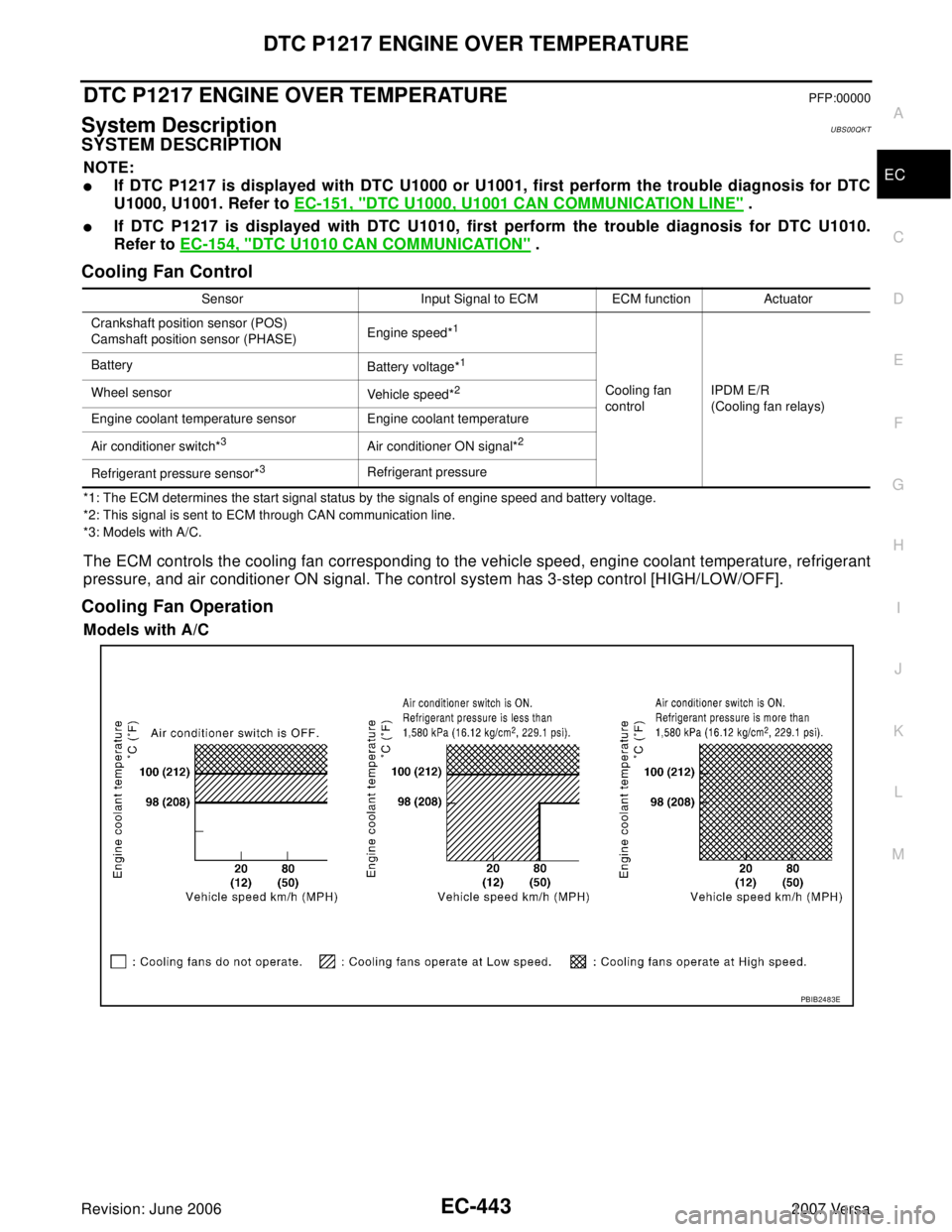
DTC P1217 ENGINE OVER TEMPERATURE
EC-443
C
D
E
F
G
H
I
J
K
L
MA
EC
Revision: June 20062007 Versa
DTC P1217 ENGINE OVER TEMPERATUREPFP:00000
System DescriptionUBS00QKT
SYSTEM DESCRIPTION
NOTE:
�If DTC P1217 is displayed with DTC U1000 or U1001, first perform the trouble diagnosis for DTC
U1000, U1001. Refer to EC-151, "
DTC U1000, U1001 CAN COMMUNICATION LINE" .
�If DTC P1217 is displayed with DTC U1010, first perform the trouble diagnosis for DTC U1010.
Refer to EC-154, "
DTC U1010 CAN COMMUNICATION" .
Cooling Fan Control
*1: The ECM determines the start signal status by the signals of engine speed and battery voltage.
*2: This signal is sent to ECM through CAN communication line.
*3: Models with A/C.
The ECM controls the cooling fan corresponding to the vehicle speed, engine coolant temperature, refrigerant
pressure, and air conditioner ON signal. The control system has 3-step control [HIGH/LOW/OFF].
Cooling Fan Operation
Models with A/C
Sensor Input Signal to ECM ECM function Actuator
Crankshaft position sensor (POS)
Camshaft position sensor (PHASE)Engine speed*
1
Cooling fan
controlIPDM E/R
(Cooling fan relays) Battery
Battery voltage*
1
Wheel sensor
Vehicle speed*2
Engine coolant temperature sensor Engine coolant temperature
Air conditioner switch*
3Air conditioner ON signal*2
Refrigerant pressure sensor*3Refrigerant pressure
PBIB2483E
Page 1621 of 2896
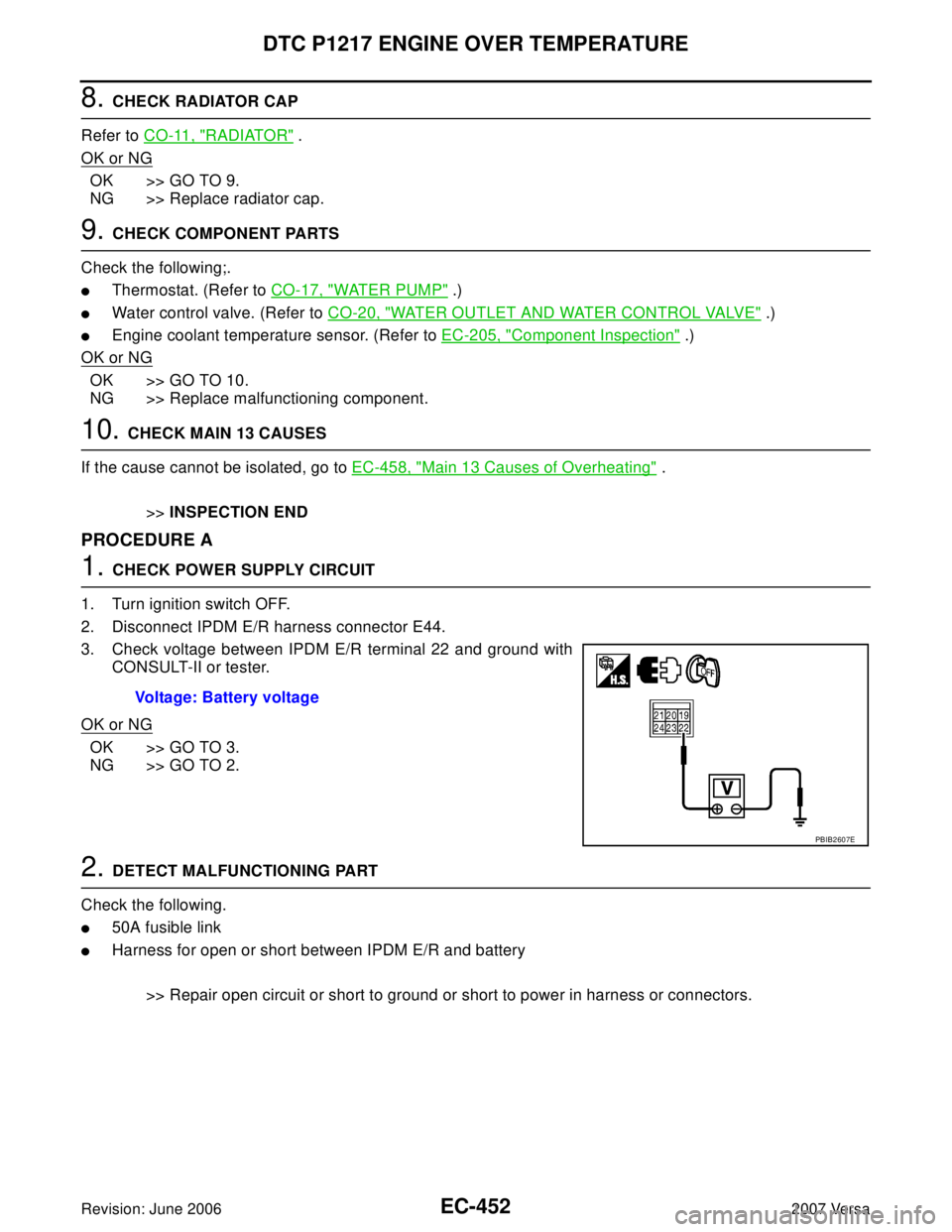
EC-452Revision: June 2006
DTC P1217 ENGINE OVER TEMPERATURE
2007 Versa
8. CHECK RADIATOR CAP
Refer to CO-11, "
RADIATOR" .
OK or NG
OK >> GO TO 9.
NG >> Replace radiator cap.
9. CHECK COMPONENT PARTS
Check the following;.
�Thermostat. (Refer to CO-17, "WATER PUMP" .)
�Water control valve. (Refer to CO-20, "WATER OUTLET AND WATER CONTROL VALVE" .)
�Engine coolant temperature sensor. (Refer to EC-205, "Component Inspection" .)
OK or NG
OK >> GO TO 10.
NG >> Replace malfunctioning component.
10. CHECK MAIN 13 CAUSES
If the cause cannot be isolated, go to EC-458, "
Main 13 Causes of Overheating" .
>>INSPECTION END
PROCEDURE A
1. CHECK POWER SUPPLY CIRCUIT
1. Turn ignition switch OFF.
2. Disconnect IPDM E/R harness connector E44.
3. Check voltage between IPDM E/R terminal 22 and ground with
CONSULT-II or tester.
OK or NG
OK >> GO TO 3.
NG >> GO TO 2.
2. DETECT MALFUNCTIONING PART
Check the following.
�50A fusible link
�Harness for open or short between IPDM E/R and battery
>> Repair open circuit or short to ground or short to power in harness or connectors. Voltage: Battery voltage
PBIB2607E
Page 1625 of 2896
EC-456Revision: June 2006
DTC P1217 ENGINE OVER TEMPERATURE
2007 Versa
11 . CHECK MAIN 13 CAUSES
If the cause cannot be isolated, go to EC-458, "
Main 13 Causes of Overheating" .
>>INSPECTION END
PROCEDURE B
1. CHECK POWER SUPPLY CIRCUIT
1. Turn ignition switch OFF.
2. Disconnect IPDM E/R harness connector E44.
3. Check voltage between IPDM E/R terminal 22 and ground with
CONSULT-II or tester.
OK or NG
OK >> GO TO 3.
NG >> GO TO 2.
2. DETECT MALFUNCTIONING PART
Check the following.
�50A fusible link
�Harness for open or short between IPDM E/R and battery
>> Repair open circuit or short to ground or short to power in harness or connectors. Voltage: Battery voltage
PBIB2607E
Page 1628 of 2896
DTC P1217 ENGINE OVER TEMPERATURE
EC-459
C
D
E
F
G
H
I
J
K
L
MA
EC
Revision: June 20062007 Versa
Component InspectionUBS00QL0
COOLING FAN MOTOR
Model with A/C
1. Disconnect cooling fan motor harness connectors.
2. Supply cooling fan motor terminals with battery voltage and
check operation.
Cooling fan motor should operate.
If NG, replace cooling fan motor.
Models without A/C
1. Disconnect cooling fan motor harness connectors.
2. Supply cooling fan motor terminals with battery voltage and
check operation.
Cooling fan motor should operate.
If NG, replace cooling fan motor.
Te r m i n a l s
(+) (-)
Cooling fan motor 1 2
SEF 8 88 V
Speedterminals
(+) (−)
Cooling fan motorLow 14
23
High 1 and 2 3 and 4
SEF 7 34 W
Page 1629 of 2896
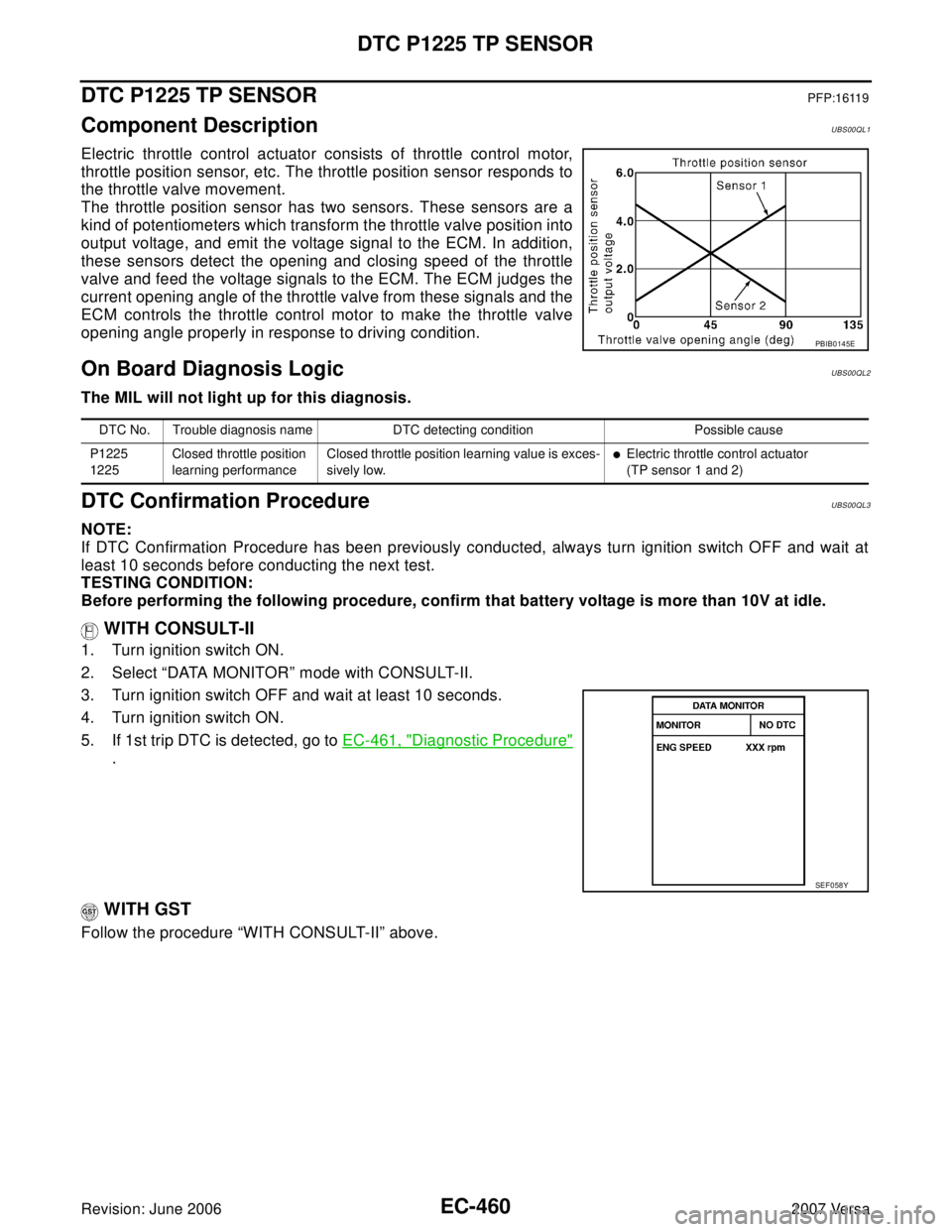
EC-460Revision: June 2006
DTC P1225 TP SENSOR
2007 Versa
DTC P1225 TP SENSORPFP:16119
Component DescriptionUBS00QL1
Electric throttle control actuator consists of throttle control motor,
throttle position sensor, etc. The throttle position sensor responds to
the throttle valve movement.
The throttle position sensor has two sensors. These sensors are a
kind of potentiometers which transform the throttle valve position into
output voltage, and emit the voltage signal to the ECM. In addition,
these sensors detect the opening and closing speed of the throttle
valve and feed the voltage signals to the ECM. The ECM judges the
current opening angle of the throttle valve from these signals and the
ECM controls the throttle control motor to make the throttle valve
opening angle properly in response to driving condition.
On Board Diagnosis LogicUBS00QL2
The MIL will not light up for this diagnosis.
DTC Confirmation ProcedureUBS00QL3
NOTE:
If DTC Confirmation Procedure has been previously conducted, always turn ignition switch OFF and wait at
least 10 seconds before conducting the next test.
TESTING CONDITION:
Before performing the following procedure, confirm that battery voltage is more than 10V at idle.
WITH CONSULT-II
1. Turn ignition switch ON.
2. Select “DATA MONITOR” mode with CONSULT-II.
3. Turn ignition switch OFF and wait at least 10 seconds.
4. Turn ignition switch ON.
5. If 1st trip DTC is detected, go to EC-461, "
Diagnostic Procedure"
.
WITH GST
Follow the procedure “WITH CONSULT-II” above.
PBIB0145E
DTC No. Trouble diagnosis name DTC detecting condition Possible cause
P1225
1225Closed throttle position
learning performanceClosed throttle position learning value is exces-
sively low.
�Electric throttle control actuator
(TP sensor 1 and 2)
SEF 0 58 Y
Page 1631 of 2896

EC-462Revision: June 2006
DTC P1226 TP SENSOR
2007 Versa
DTC P1226 TP SENSORPFP:16119
Component DescriptionUBS00QL6
Electric throttle control actuator consists of throttle control motor,
throttle position sensor, etc. The throttle position sensor responds to
the throttle valve movement.
The throttle position sensor has two sensors. These sensors are a
kind of potentiometers which transform the throttle valve position into
output voltage, and emit the voltage signal to the ECM. In addition,
these sensors detect the opening and closing speed of the throttle
valve and feed the voltage signals to the ECM. The ECM judges the
current opening angle of the throttle valve from these signals and the
ECM controls the throttle control motor to make the throttle valve
opening angle properly in response to driving condition.
On Board Diagnosis LogicUBS00QL7
The MIL will not light up for this diagnosis.
DTC Confirmation ProcedureUBS00QL8
NOTE:
If DTC Confirmation Procedure has been previously conducted, always turn ignition switch OFF and wait at
least 10 seconds before conducting the next test.
TESTING CONDITION:
Before performing the following procedure, confirm that battery voltage is more than 10V at idle.
WITH CONSULT-II
1. Turn ignition switch ON.
2. Select “DATA MONITOR” mode with CONSULT-II.
3. Turn ignition switch OFF and wait at least 10 seconds.
4. Turn ignition switch ON.
5. Repeat steps 3 and 4 for 32 times.
6. If 1st trip DTC is detected, go to EC-463, "
Diagnostic Procedure"
.
WITH GST
Follow the procedure “WITH CONSULT-II” above.
PBIB0145E
DTC No. Trouble diagnosis name DTC detecting condition Possible cause
P1226
1226Closed throttle position
learning performanceClosed throttle position learning is not per-
formed successfully, repeatedly.
�Electric throttle control actuator
(TP sensor 1 and 2)
SEF 0 58 Y
Page 1633 of 2896
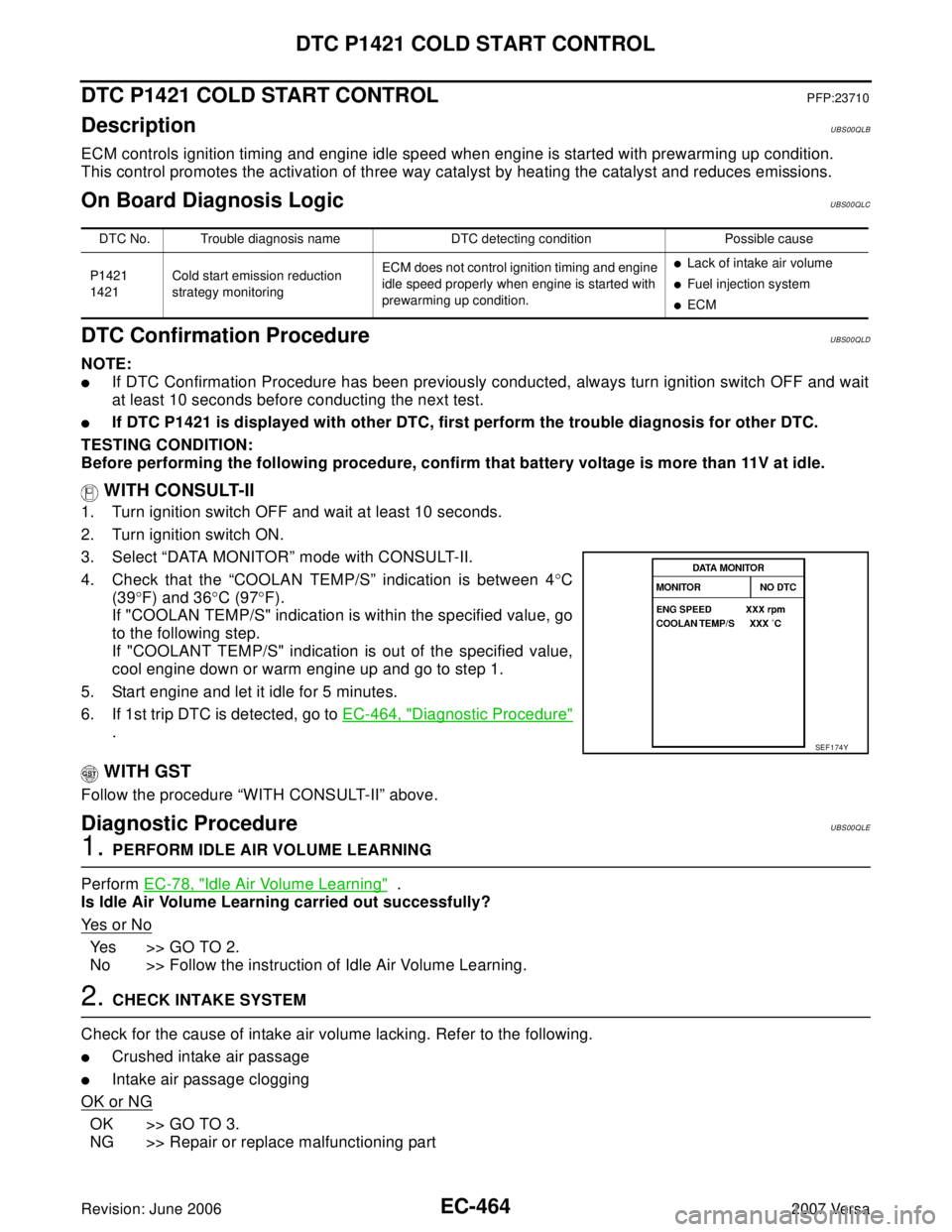
EC-464Revision: June 2006
DTC P1421 COLD START CONTROL
2007 Versa
DTC P1421 COLD START CONTROLPFP:23710
DescriptionUBS00QLB
ECM controls ignition timing and engine idle speed when engine is started with prewarming up condition.
This control promotes the activation of three way catalyst by heating the catalyst and reduces emissions.
On Board Diagnosis LogicUBS00QLC
DTC Confirmation ProcedureUBS00QLD
NOTE:
�If DTC Confirmation Procedure has been previously conducted, always turn ignition switch OFF and wait
at least 10 seconds before conducting the next test.
�If DTC P1421 is displayed with other DTC, first perform the trouble diagnosis for other DTC.
TESTING CONDITION:
Before performing the following procedure, confirm that battery voltage is more than 11V at idle.
WITH CONSULT-II
1. Turn ignition switch OFF and wait at least 10 seconds.
2. Turn ignition switch ON.
3. Select “DATA MONITOR” mode with CONSULT-II.
4. Check that the “COOLAN TEMP/S” indication is between 4°C
(39°F) and 36°C (97°F).
If "COOLAN TEMP/S" indication is within the specified value, go
to the following step.
If "COOLANT TEMP/S" indication is out of the specified value,
cool engine down or warm engine up and go to step 1.
5. Start engine and let it idle for 5 minutes.
6. If 1st trip DTC is detected, go to EC-464, "
Diagnostic Procedure"
.
WITH GST
Follow the procedure “WITH CONSULT-II” above.
Diagnostic ProcedureUBS00QLE
1. PERFORM IDLE AIR VOLUME LEARNING
Perform EC-78, "
Idle Air Volume Learning" .
Is Idle Air Volume Learning carried out successfully?
Ye s o r N o
Yes >> GO TO 2.
No >> Follow the instruction of Idle Air Volume Learning.
2. CHECK INTAKE SYSTEM
Check for the cause of intake air volume lacking. Refer to the following.
�Crushed intake air passage
�Intake air passage clogging
OK or NG
OK >> GO TO 3.
NG >> Repair or replace malfunctioning part
DTC No. Trouble diagnosis name DTC detecting condition Possible cause
P1421
1421Cold start emission reduction
strategy monitoringECM does not control ignition timing and engine
idle speed properly when engine is started with
prewarming up condition.
�Lack of intake air volume
�Fuel injection system
�ECM
SEF 1 74 Y
Page 1645 of 2896
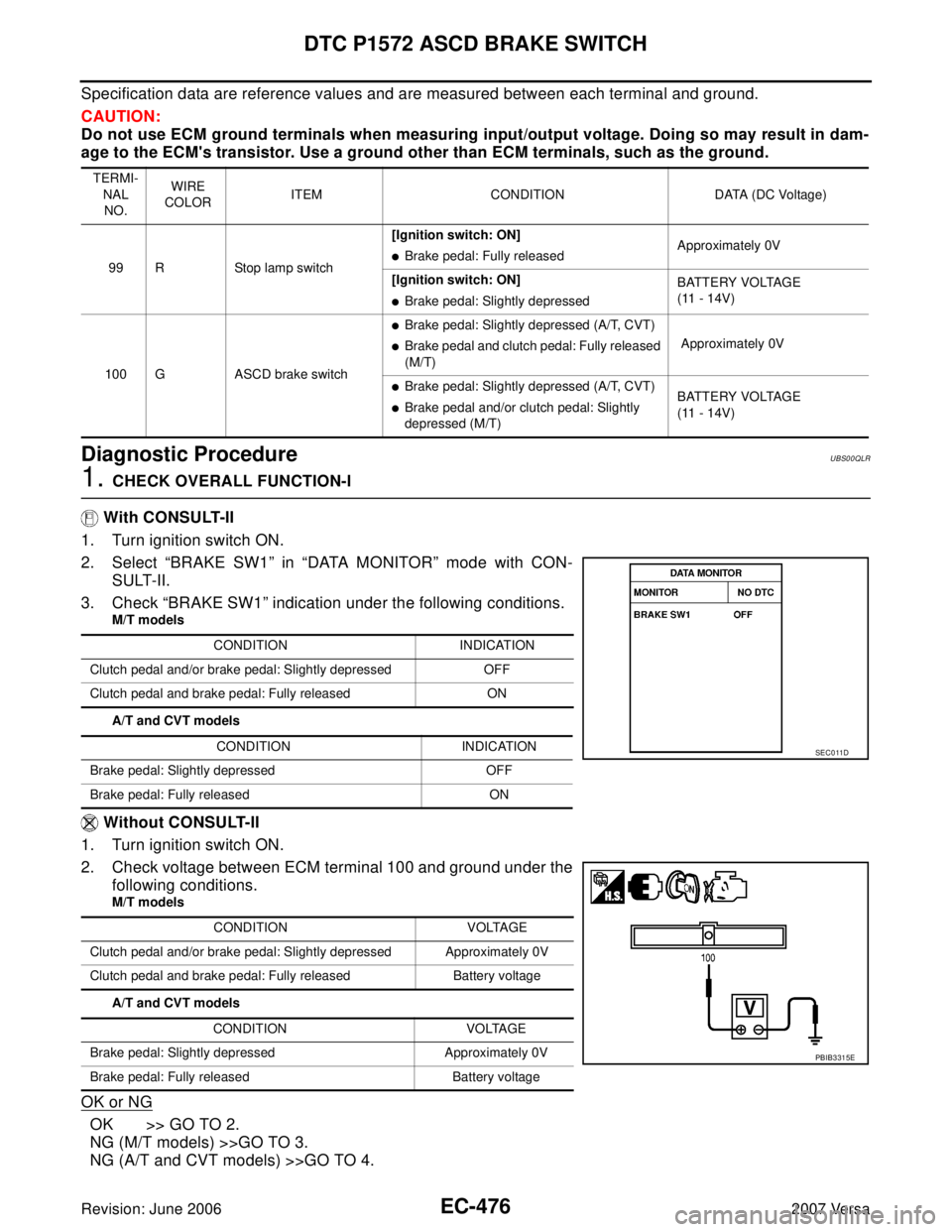
EC-476Revision: June 2006
DTC P1572 ASCD BRAKE SWITCH
2007 Versa
Specification data are reference values and are measured between each terminal and ground.
CAUTION:
Do not use ECM ground terminals when measuring input/output voltage. Doing so may result in dam-
age to the ECM's transistor. Use a ground other than ECM terminals, such as the ground.
Diagnostic ProcedureUBS00QLR
1. CHECK OVERALL FUNCTION-I
With CONSULT-II
1. Turn ignition switch ON.
2. Select “BRAKE SW1” in “DATA MONITOR” mode with CON-
SULT-II.
3. Check “BRAKE SW1” indication under the following conditions.
M/T models
A/T and CVT models
Without CONSULT-II
1. Turn ignition switch ON.
2. Check voltage between ECM terminal 100 and ground under the
following conditions.
M/T models
A/T and CVT models
OK or NG
OK >> GO TO 2.
NG (M/T models) >>GO TO 3.
NG (A/T and CVT models) >>GO TO 4.
TERMI-
NAL
NO.WIRE
COLORITEM CONDITION DATA (DC Voltage)
99 R Stop lamp switch[Ignition switch: ON]
�Brake pedal: Fully releasedApproximately 0V
[Ignition switch: ON]
�Brake pedal: Slightly depressedBATTERY VOLTAGE
(11 - 14V)
100 G ASCD brake switch
�Brake pedal: Slightly depressed (A/T, CVT)
�Brake pedal and clutch pedal: Fully released
(M/T) Approximately 0V
�Brake pedal: Slightly depressed (A/T, CVT)
�Brake pedal and/or clutch pedal: Slightly
depressed (M/T)BATTERY VOLTAGE
(11 - 14V)
CONDITION INDICATION
Clutch pedal and/or brake pedal: Slightly depressed OFF
Clutch pedal and brake pedal: Fully released ON
CONDITION INDICATION
Brake pedal: Slightly depressed OFF
Brake pedal: Fully released ON
CONDITION VOLTAGE
Clutch pedal and/or brake pedal: Slightly depressed Approximately 0V
Clutch pedal and brake pedal: Fully released Battery voltage
CONDITION VOLTAGE
Brake pedal: Slightly depressed Approximately 0V
Brake pedal: Fully released Battery voltage
SEC0 11D
PBIB3315E